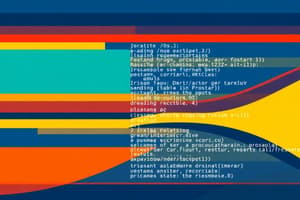Podcast
Questions and Answers
What is the main purpose of using high-speed memory in a computer system?
What is the main purpose of using high-speed memory in a computer system?
- To manage I/O instructions
- To differentiate between user mode and monitor mode
- To hold recently-accessed data (correct)
- To execute privileged instructions
Why is a cache management policy required in computer systems?
Why is a cache management policy required in computer systems?
- To ensure consistent data in multiple storage levels (correct)
- To protect interrupt vectors from memory corruption
- To switch between user and monitor modes efficiently
- To prevent user programs from accessing privileged instructions
What is the significance of the 'mode bit' in computer hardware?
What is the significance of the 'mode bit' in computer hardware?
- Indicates the type of I/O instructions allowed
- Differentiates between user mode and monitor mode (correct)
- Protects memory from interrupt vectors
- Determines the speed of high-speed memory access
Why are all I/O instructions considered privileged instructions?
Why are all I/O instructions considered privileged instructions?
In a computer system, what is the purpose of memory protection?
In a computer system, what is the purpose of memory protection?
What function does dual-mode operation serve in an operating system?
What function does dual-mode operation serve in an operating system?
What state is a process in when it is waiting for some event before proceeding?
What state is a process in when it is waiting for some event before proceeding?
Which component of a process holds the address of the next instruction to be executed?
Which component of a process holds the address of the next instruction to be executed?
In which state is a process said to be runnable but temporarily stopped running?
In which state is a process said to be runnable but temporarily stopped running?
What does the Running State of a process signify?
What does the Running State of a process signify?
Which state signifies that a process has finished its execution?
Which state signifies that a process has finished its execution?
What is the primary function of the long-term scheduler or job scheduler?
What is the primary function of the long-term scheduler or job scheduler?
Which scheduler is responsible for selecting a process from ready processes to allocate the CPU?
Which scheduler is responsible for selecting a process from ready processes to allocate the CPU?
In the context of CPU scheduling, what is the major difference between I/O-bound and CPU-bound processes?
In the context of CPU scheduling, what is the major difference between I/O-bound and CPU-bound processes?
What does the medium-term scheduler do in the context of process scheduling?
What does the medium-term scheduler do in the context of process scheduling?
How does the long-term scheduler differ from the short-term scheduler in terms of frequency of execution?
How does the long-term scheduler differ from the short-term scheduler in terms of frequency of execution?
What does the system do during a context switch?
What does the system do during a context switch?
What happens in terms of resource sharing between parent and child processes?
What happens in terms of resource sharing between parent and child processes?
What system call creates a new process in UNIX?
What system call creates a new process in UNIX?
When does a parent process typically wait for its children to terminate?
When does a parent process typically wait for its children to terminate?
What is the outcome if a parent process terminates?
What is the outcome if a parent process terminates?
In case a child process exceeds its allocated resources, what may lead to its termination?
In case a child process exceeds its allocated resources, what may lead to its termination?
What defines cooperating processes in an operating system?
What defines cooperating processes in an operating system?




